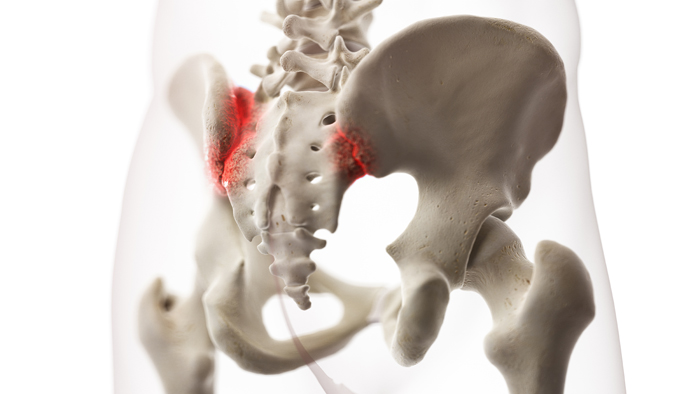Sacroiliac Joint Pain Treatment & Diagnostics in Karol Bagh, Delhi
Sacroiliac Joint Pain
Have you ever experienced sharp pain in your lower back and wondered what the reason for your pain is? It may be because of issues related to the sacroiliac joint. Several factors cause sacroiliac joint pain.
Correct diagnosis and proper treatment are essential. For this, you need to visit one of the best pain management hospitals in New Delhi or consult a sacroiliac joint specialist near you for a favorable prognosis.
What is Sacroiliac Joint?
The sacroiliac joint (SI joint) lies between the sacrum, a triangle-shaped bone, and the ilium bone. There are two SI joints on either side of your lower back. They act as a shock absorber, decrease stress on the spine and pelvis, carry the weight from your upper body, and shift it to the lower body.

What Causes Sacroiliac Joint Pain?
Different causes that increase the risk of sacroiliac joint pain include:
- An injury or trauma resulting from accidents can damage ligaments, causing joint pain.
- It can occur because of previous spine surgery
- Osteoarthritis can damage any joint, including the SI joint.
- Ankylosing spondylitis is an inflammatory arthritis condition that affects the spine and bones, causing joint pain.
- During pregnancy, the SI joint becomes wide and less stable because of hormone release.
- Abnormal walking patterns or uneven legs can also lead to SI joint dysfunction.
What Are the Symptoms of Sacroiliac Joint Pain?
- Sharp or stabbing pain in the lower back, buttocks, hips, groin region and pelvis.
- The pain may worsen when standing up from a sitting position, walking up a staircase or bending.
- For a person with spondylitis, you experience back stiffness.
- Non-joint symptoms like fatigue, eye pain and blurry vision
- Weakness, numbness or tingling sensation in the legs
How Are SI Joint Problems Diagnosed?
As SI joints are located deep within the body, it is difficult to diagnose the condition. Imaging tests like MRI, X-ray and CT scans do not show the damage of the joint despite the problem present. So, doctors inject a numbing agent into the joint that acts as a standard for SI joint dysfunction. If 75% of the pain goes away in shorter periods, they conclude that you have sacroiliac joint pain.
When Do You Need to See a Doctor?
Consult a specialist if the pain persists for extended periods or if you have any other disease conditions. Diagnosing the pain is of paramount importance, so visit the best pain management hospital in New Delhi for proper diagnosis and treatment.
Request an appointment at Apollo Spectra Hospitals, Karol Bagh, New Delhi.
Call 1860 500 2244 to book an appointment.
How is Sacroiliac Joint Pain Treated?
Depending on the severity of the pain, your doctor may recommend one of the following procedures.
Physical Therapy and Exercises
- Before prescribing the medications for the pain, doctors suggest physical therapy and light stretching exercises to strengthen the SI joints and ease the pain.
- They recommend massage techniques to correct the joint alignment.
- Wearing a sacroiliac belt helps you support the joint.
- Hot and cold therapies can relax the muscles and ease the pain.
Non-Surgical Therapy
If there is no improvement with physical therapy, then they recommend medication to reduce the pain. These include:
- Anti-inflammatory drugs like NSAIDs can often help relieve pain.
- Muscle relaxants or other pain relievers can help ease severe SI joint pain and muscle cramps.
- Corticosteroid injections are injected directly into the SI joint to reduce inflammation and joint pain.
- Tumor necrosis factor inhibitors can help reduce inflammation caused by spondyloarthritis.
Surgical Procedures
People who have severe SI joint pain may require surgery if they do not respond to medication.
- Radiofrequency ablation is a minimally invasive technique that uses electric current to destroy the nerve fibers that send pain signals to the brain. Pulsed radiofrequency is a similar procedure that provides pain relief without damage to the nerves.
- SI joint fusion: In this procedure, doctors surgically fuse the bones with metal plates.
Conclusion
Sacroiliac joint pain is one of the most common causes of lower back pain. The pain may be caused by pregnancy, inflammatory disorders, injury or strain to the spine. Consult the best sacroiliac joint pain specialist in Delhi to choose an effective treatment strategy for your pain.
Yes, it is possible. This condition is called bilateral SI joint dysfunction, but it is seen rarely in people, and for this, doctors perform SI-joint fusion surgery.
Vaginal delivery is possible for people who have been diagnosed with SI joint pain or spondylitis or even if they have undergone SI joint fusion surgery. Consult your doctor and discuss the treatment options.
Some exercises aggravate the pain. So you better avoid activities that increase the pressure on the joints. Some of them are crunches, sit-ups and lifting heavy objects and avoid going for long rides on bikes, playing sports like football, basketball, golf and tennis.
Our Doctors
DR. SORABH GARG
MBBS, DNB (Anaesthes...
| Experience | : | 16 Yeras Experience |
|---|---|---|
| Speciality | : | Pain Management... | Location | : | Karol Bagh |
| Timings | : | Mon - Sat : 9:00 AM ... |
Our Top Specialities
NOTICE BOARD
CONTACT US
CONTACT US
 Book Appointment
Book Appointment



.svg)
.svg)
.svg)
.svg)








